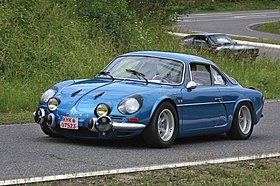| Alpine A110 | |
|---|---|
 A110 1300G | |
| Overview | |
| Manufacturer | Alpine |
| Production | 1963–1977 |
| Assembly | Dieppe, France |
| Designer | Giovanni Michelotti[1][2] |
| Body and chassis | |
| Class | Sports car (S) |
| Body style | 2-door Berlinette |
| Layout | Rear-engine, rear-wheel-drive |
| Powertrain | |
| Engine |
|
| Transmission | 5-speed manual |
| Dimensions | |
| Wheelbase | 2,099–2,180 mm (82.6–85.8 in) |
| Length | 3,850 mm (152 in) |
| Width | 1,471–1,550 mm (57.9–61.0 in) |
| Curb weight | 706 kg (1,556 lb) |
| Chronology | |
| Predecessor | Alpine A108 |
| Successor | Alpine A310 Alpine A110 (2017) (spiritual) |
The Alpine A110 is a sports car produced by French automobile manufacturer Alpine from 1963 to 1977. The car was styled as a "berlinette", which in the post-WWII era refers to a small enclosed two-door berline, better-known as a coupé.[3] The Alpine A110 succeeded the earlier A108. The car was powered by a succession of Renault engines. A car also named Alpine A110 was introduced in 2017.
The Alpine A110 experienced a remarkable evolution in terms of power output throughout its production years. Initially, the A110 had an output of just 51 horsepower, which was adequate for a car weighing only 620 kilograms. However, by the end of the A110's production run, its power output had increased to 180 horsepower. This impressive increase in power contributed to the car's success on the rally stages of Europe. The A110's crowning achievements included 1-2-3 finishes at both the 1971 and 1973 Monte Carlo rallies, and it used Renault 16 engines at the time. In 1973, Alpine won the inaugural manufacturer's World Rally Championship, defeating competitors such as Lancia, Porsche, and Ford. However, by 1974, advances in rally competition led to a significant shift in the landscape of the sport, and the Alpine A110, which had become outdated, struggled to keep up with its rivals. As a result, sales of the A110 declined, prompting Renault to step in and purchase the company outright in an effort to save it. Despite being surpassed by newer rally cars, the A110's legacy as a successful and iconic rally car remains, and its victories in the early 1970s solidified its place in motorsport history.[4]
- ^ "Designer". ajovalo.net. Retrieved 8 February 2012.
- ^ Cumberford, Robert (August 2016). "The Cumberford Perspective". Sports Car Market. 28 (8): 68.
- ^ Haajanen, Lennart (1 October 2007). Illustrated Dictionary of Automobile Body Styles. Mcfarland & Co Inc. p. 20. ISBN 978-0786437375.
- ^ Cite error: The named reference
carthrottlewas invoked but never defined (see the help page).